|
 Prehistoric Construction Techniques.
Prehistoric Construction Techniques.
|
The earliest examples of stone masonry in both the 'Old'
and 'New' worlds demonstrates a high skill level, something which is often
suggested as being a result of the existing knowledge of carpentry at the
transition in working from wood to stone. This idea is borne out
somewhat in Egypt where for example, the masonry of the ceilings in the temples of
1st dynasty Saqqara were carved to imitate the 'reed-bundle' ceilings
of pre-dynastic Egypt. There is however, no evidence of such a
transition in the Americas.
Featured Masonry Techniques:
|
|
|
|
|
The transport and use of
unnecessarily large blocks of stone, the specific selectivity
of stone type along with various examples of 'extreme' masonry
at numerous sacred and ancient monuments is
starting to reveal a reverence for stone itself, an idea which
has foundation in mythology, religion and can still be seen
today at Jerusalem, Mecca, the 'Lignum' of India and at the
crowning of any new king or Queen in UK (i.e. Scottish
'Stone-of-scone', English 'kings-stone') etc.
It is
noticeable that there are several specific construction
techniques in the masonry of (apparently unrelated) cultures
from around the ancient world. The specific similarity in
design, technique and engineering skills is, in certain
cases very suggestive of a common source of knowledge, or at
the least - of contact between cultures. In response, it has
been argued that such similarities are
'co-evolutionary', being the natural result of working with
stone.
The following examples
demonstrate the sophisticated skills of the prehistoric masons.
|
Several structures show the blocks cut
with an internal angle, so as to 'fold' the stone around corner's. It is
suggested that this was incorporated as an earthquake 'preventative'.
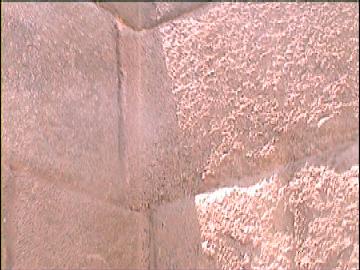 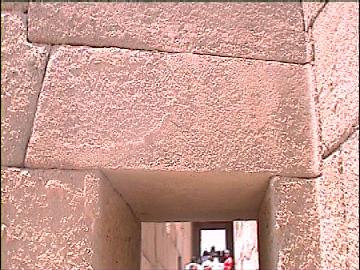
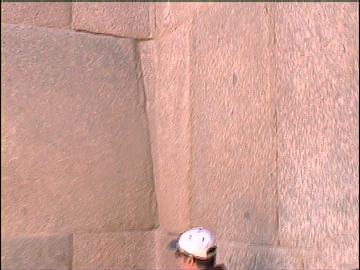
Valley-Temple,
Ghiza, Egypt.
- There are several stones with this design
feature in the valley-temple. It is interesting to note that the stones have been
cut so as to continue
only a short distance around the corner which hints at the idea that
style might have been involved (rather
than, or as well as, function).
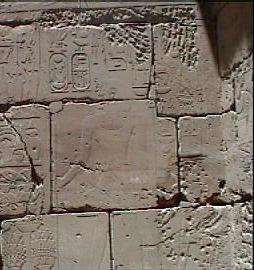
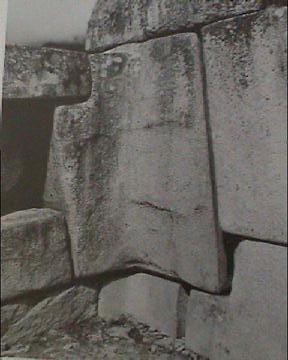
Luxor, Egypt. (Left),
Machu
Pichu , Peru (Right).
|
|
It is often suggested that this
design feature was incorporated into constructions as an 'earthquake'
preventative. The fact that the constructions exist in such good condition
after so long, in itself supports this idea.
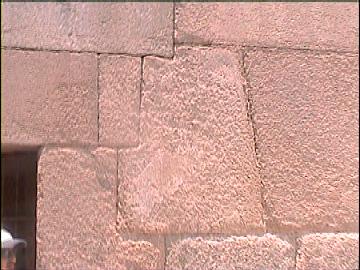
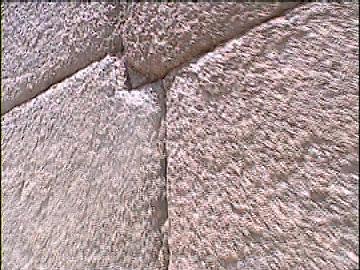
Multi-faceted stones -
Valley-temple, Ghiza, Egypt.
While the Egyptian
examples (above), followed a horizontal plane, the South American examples
(below), are polygonal, apparently following neither vertical nor horizontal
planes, a process which would have required a considerably higher level of
technical skill.
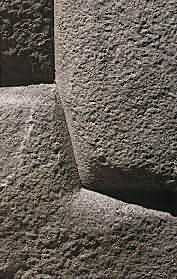
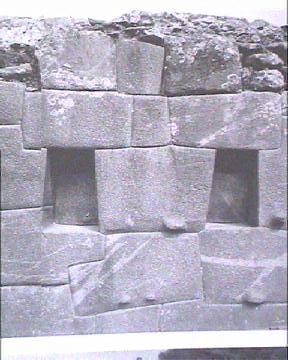
The Inca masonry of south America is probably the
finest the world has ever seen.
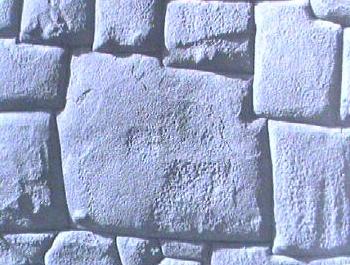
S. America,
Cuzco.
'Stone of the twelve Angels'.
(2)
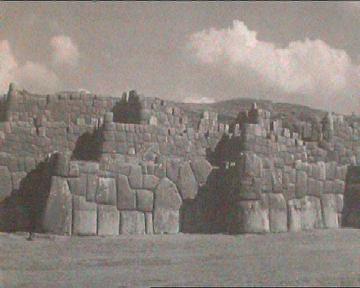 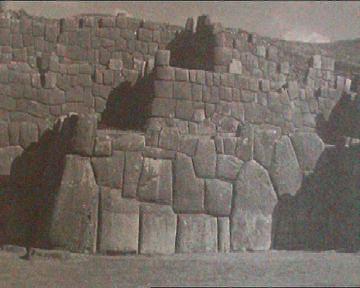
Sacsayhuaman -
One of the greatest walls of all time.
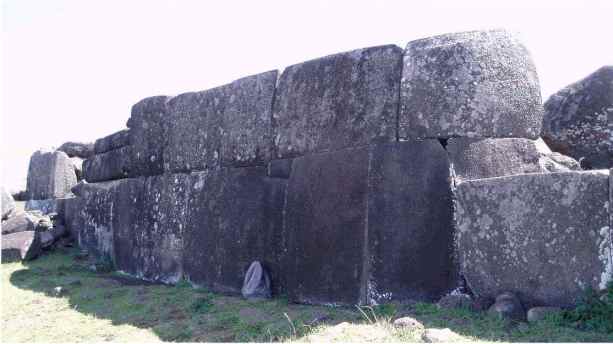
One of the 300 Ahu Platforms surrounding
Easter Island. Made of Basalt and with blocks
several tons each, The style of masonry shows a stark similarity to South
American masonry examples above.
|
|
Another construction feature commonly
suggested as an earthquake preventative is the means used to join huge
blocks together. It is believed that copper (or silver) was used at
Tiahuanaco (below), both of which are soft metals.
Some examples from the 'Old-World' (Namely Egypt, and Cambodia)..
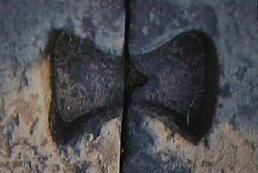
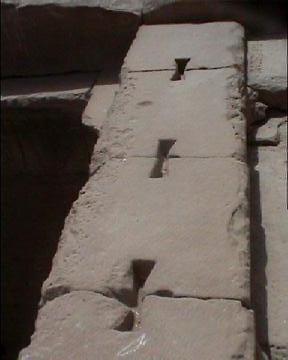
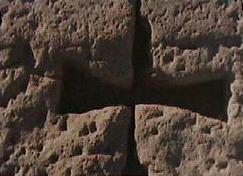
From left to right:
Angkor Watt,
Karnak,
and
Denderra.
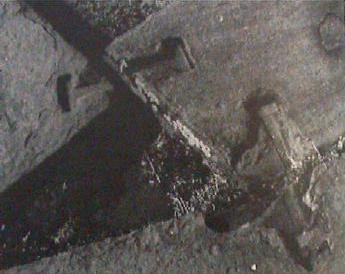
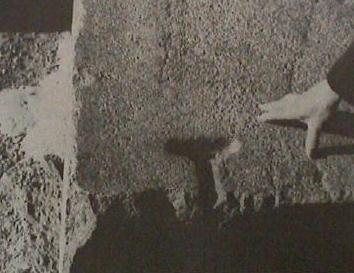
And from the 'New-World'.:
Tiahuanaco,
and
Ollantaytambo.
It has also been suggested that these 'ties'
were employed to 'ground' structures properly (often made of conducting
Quartzite).
|
|
Quarry-Marks (for splitting stone): |
|
The megalithic builders employed the same method of splitting quartz, at different
locations all around the world. This is not unusual, as it is probably the best
method, and is still widely used today. By far the easiest way of splitting
Quartz stone is to chip a series of holes into the stone, which are then
packed with 'wedges and shims' (made of wood). Following the addition
of water, the wedges expanded and the stone splits along the line.
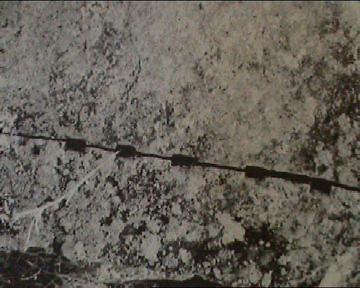
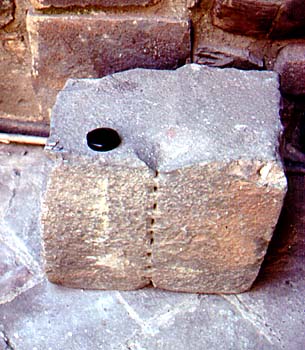
Examples from S. America:
Left: Machu Pichu
(1)
and Right: Cuzco.
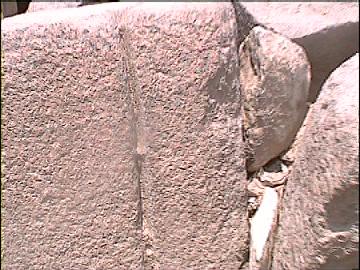 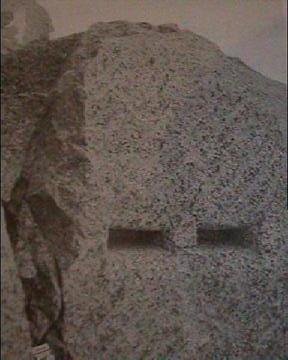
From
Egypt: Menkaure's pyramid,
Giza (left), and
at Aswan (right).
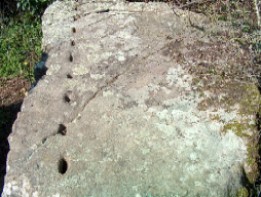
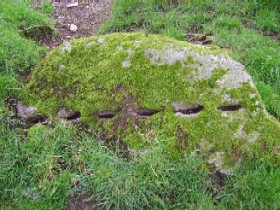
From
Carnac, France, (left), and
Castleruddery, Ireland (right).
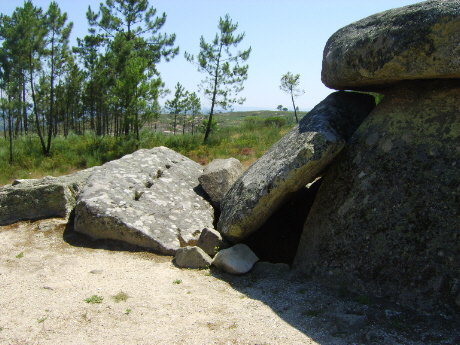
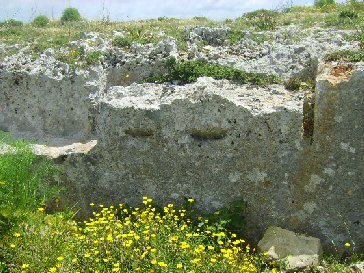
More examples from Portugal (left), and From
Malta
(right).
(Click here for more on this
subject)
|
| 'Manoeuvring
Protuberances' : |
|
These small protuberances are found on the oldest (and arguably most sacred)
Egypt and South American constructions. They are generally assumed to have functioned as
'hitching points' for
manoeuvring the blocks into place, however there are several examples where they
have been left as if to demonstrate some other meaning...
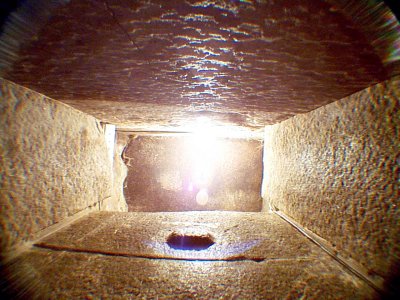
The 'Boss' mark on the stone above the passage entry into the 'King's
chamber' in the great pyramid is often suggested as being the remains of one
of these protuberances.
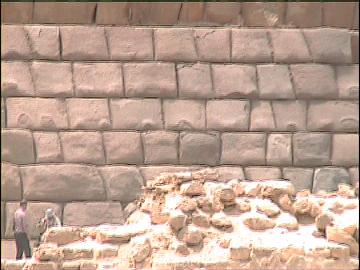
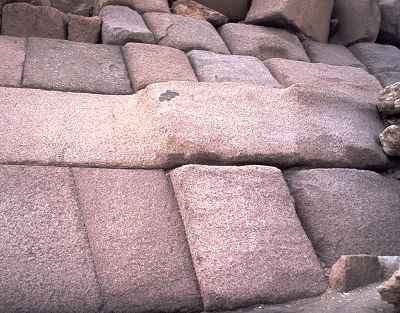
They are found on the exterior granite facing-stones of Menkaure's Pyramid at Giza.
It is possible to see how the process of smoothing off of
the granite casing stones was started on the Eastern face of Menkaures pyramid. The smoothing process was achieved with
the use of Dolerite mauls which were able to pound the softer granite. This
process can still be seen today at the Aswan granite quarries, where the
granite for Giza originally came from.
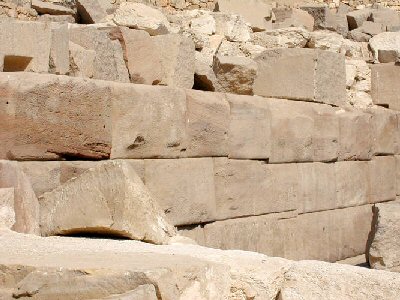
The same marks are also found in the
Osireion, at Abydoss. One of the several reasons to support
the theory that it was
contemporary with the Valley temple at Ghiza.
Similar 'protuberances' can be seen at several Inca sites in
South America.
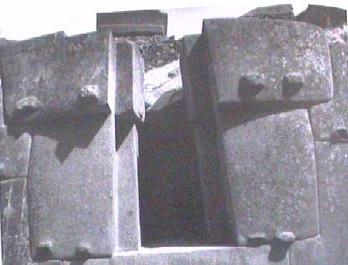
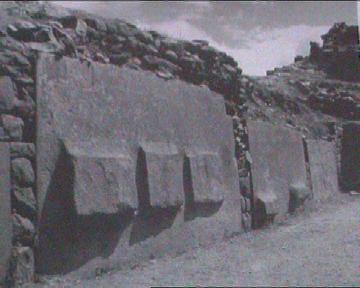
At Ollantaytambo,
Peru, the 'protuberances' take on a whole different meaning altogether, as
they could almost be classed as stylised over functional.
Although both locations
have the same 'protuberances', the Inca block-work was multi-faceted, while
at Ghiza, they were laid in even courses.
|
|
Mortise and Tenon Joints: |
It is perhaps surprising to find that some of
the earliest known examples of masonry exhibit a sophisticated
understanding of joinery. This particular construction feature is reasonably
explained as having followed the transition from building structures
first from wood then stone.
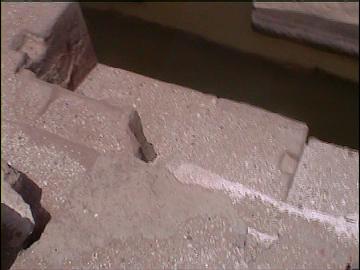
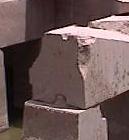
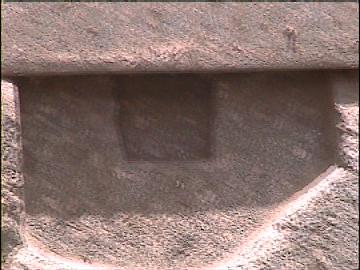
Some examples of the Various 'Mortise and
Tenon' joins used in the construction of
The Osirion, at Abydoss,
in Egypt. This is considered one of the oldest buildings in Egypt, and
is quoted as having only one other structure of contemporary design, that being
the Valley-Temple at Giza. Both
structures used the technique of continuous-lintelled trilithon's, seen also
at Stonehenge III.
(Click here for a comparison of
the two structures)
Mortise-and-tenon joints had, of course, been used previously in Bronze Age
ships in Egypt, as in the construction of the Khufu�s boat at Giza (ca. 2600
B. C.) and Senwosret III�s boats (ca. 1850 B.C.) at Dashur (Lipke 1984, 64;
Steffy 1994, 25-27, 32-36, Patch and Haldane 1990). These early Egyptian
examples of mortise-and-tenons, however, were freestanding and not pegged to
lock adjacent strakes to one another. Rather, their primary function was to
align the planks during construction, which were then fastened to each other
with ligatures. This tradition of shipbuilding appears to have persisted at
least as late as the 5th century B.C. when Herodotus observed
nearly identical construction methods still in use in Egypt. In his
oft-cited quotation, Herodotus noted that short planks were joined to each
other with long, close-set tenons, which were then bound in the seams from
within with papyrus fibers (Haldane & Shelmerdine 1990). There is no
mention of locking the close-set tenons with pegs. The Egyptians were,
however, fully aware of pegged mortise-and-tenon joints at last since the
Old Kingdom (Dynasty III: ca. 2700-2600 B. C.) and used them in woodwork
requiring this type of fastening (Lucas & Harris 1962, 451), but, as far as
we can determine, they did not resort to their use in shipbuilding, unless
they restricted their use to seagoing ships only, for which we have
surviving examples.
(9)
The
Stonehenge Sarsen Stones :
In its complete form the outermost stone setting would have consisted of a circle of 30
upright sarsen stones, of which 17 still stand, each weighing about 25 tons.
The tops of these uprights were linked by a continuous ring of horizontal
sarsen lintels, only a small part of which is now still in position. The
stones in the sarsen circle were carefully shaped and the horizontal lintels
joined not only by means of simple mortise-and-tenon joints, but they were
also locked using what is effectively a dovetail joint. The edges were
smoothed into a gentle curve which follows the line of the entire circle.
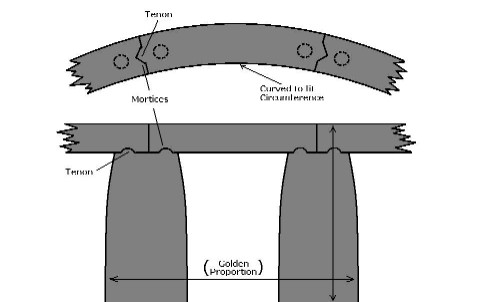
The sarsen-ring at
Stonehenge (whose
official inner diameter is 97ft or 1162.8 primitive inches), has a
circumference of 3652.4 primitive inches. Note: This is also exactly one
�quarter-aroura�, as measured in ancient Egypt
(1). Sir Norman Lockyer
also detected similarities between the masonry of the Blood/Chalice-well
at
Glastonbury and
that which
he
had seen in Egypt.
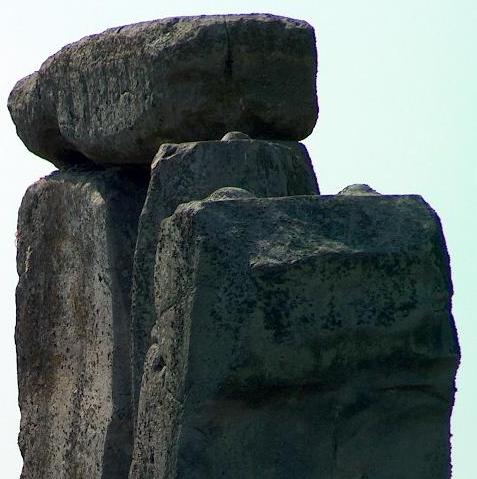
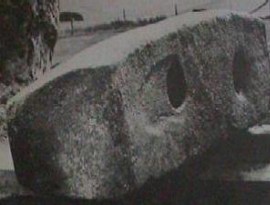
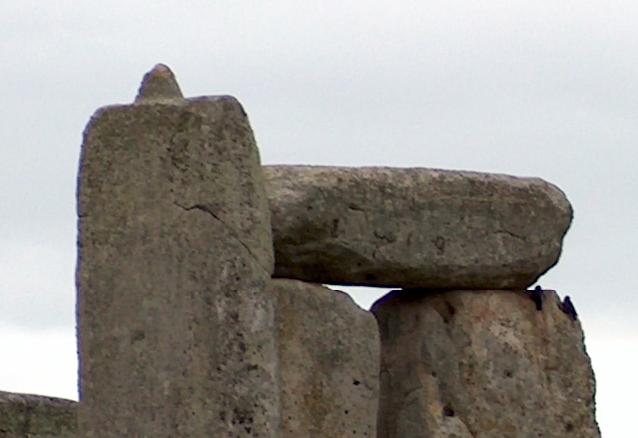
The pictures above illustrate the sophisticated
construction techniques applied to the
Stonehenge sarsen-stones, which are
dated at approximately 2,500 BC, however if we follow Lockyer's lead, and
look closer at Egyptian masonry, we find similar features were applied to
construction of the the Osirion (above), a temple dated to a far earlier
time, and a site suggested by Lockyer to have alignments suggesting an
association to the summer-solstice sunrise
(2).
(More about Stonehenge)
And finally, from the Indus Valley Culture...
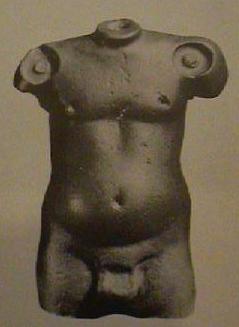
This incredible stone casting is from Harappa in
Pakistan (c. 2,500-2,100 BC).
|
It was claimed by Petrie
that early dynastic Egyptians used drills for some of their
constructions. The following images suggest he was right.
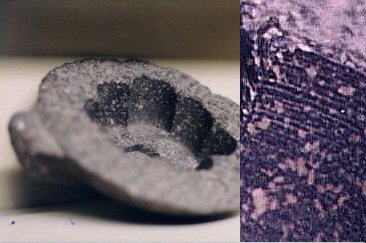
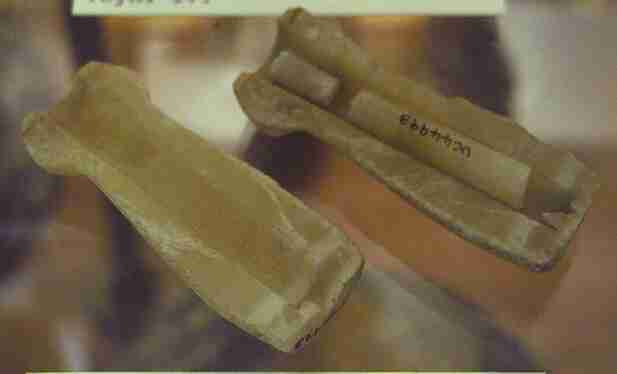
Evidence for
drilling in ancient Egypt. Marks in the kings-coffer suggest that it
too was hollowed by core-drilling.
The Capstones of Pierres Plates in France
have what appear to be drill-marks on the top-sides.
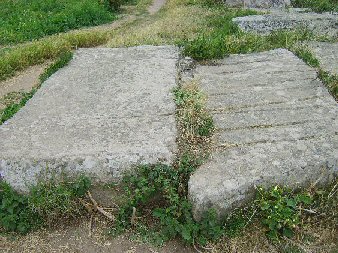
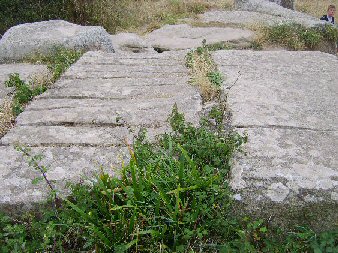 The 'Drill-marks' on some stones match those on
others, suggesting they were split in half.
(More
about Pierres plates) Surgical Drilling in
Prehistory.
Although not directly
connected with construction, evidence for drilling goes back
several thousand years, as testified by the numerous examples
of prehistoric dentistry and Trepanning, both involving
drilling procedures. Article: MSNBC (2006) - Proving
prehistoric man�s ingenuity and ability to withstand and inflict
excruciating pain, researchers have found that dental drilling dates
back 9,000 years. Primitive dentists
drilled nearly perfect holes into live but undoubtedly unhappy patients
between 5500 B.C. and 7000 B.C., an article in Thursday�s issue of the
journal Nature reports.
Researchers carbon-dated at least nine skulls with 11 drill holes found
in a Pakistan graveyard.
(Link to full article:
http://www.msnbc.msn.com/id/12168308/)
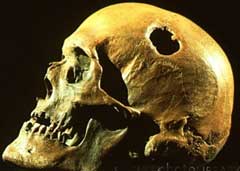 Trepanation:
Skulls with signs of trepanning were found practically in all
parts of the world where man has lived. Trepanning is probably
the oldest surgical operation known to man: evidence for it
goes back as far as in 40,000 year-old Cro-Magnon sites. The
Egyptians invented the circular trephine, made by a tube with
serrated borders, which cuts much easier by means of rotation,
and which was then extensively used in Greece and Rome, and
gave origin to the "crown" trephine, used in Europe from the
first to the 19th century. Trepanation:
Skulls with signs of trepanning were found practically in all
parts of the world where man has lived. Trepanning is probably
the oldest surgical operation known to man: evidence for it
goes back as far as in 40,000 year-old Cro-Magnon sites. The
Egyptians invented the circular trephine, made by a tube with
serrated borders, which cuts much easier by means of rotation,
and which was then extensively used in Greece and Rome, and
gave origin to the "crown" trephine, used in Europe from the
first to the 19th century.
(Link to full
article:
http://www.cerebromente.org.br/n02/historia/trepan.htm )
(More about Prehistoric Surgery)
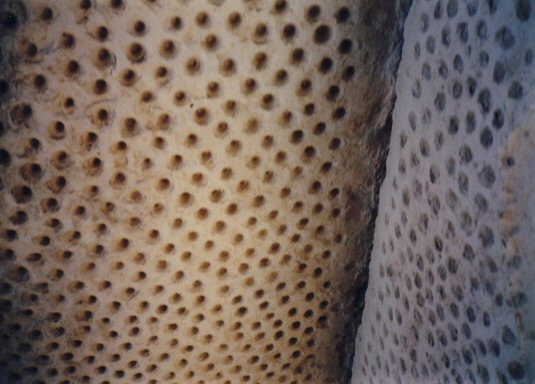
Hundreds of uniformly drilled holes on the stones at
Mnajdra, Malta.
(More about Drilling in Prehistory) |
|
The Use of Concrete in Ancient Structures: |
|
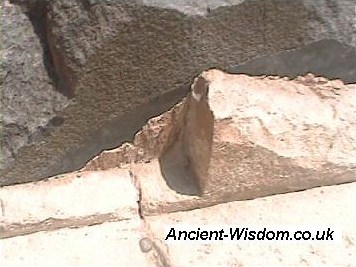 'The
Hair in the Rock',
Egypt: Prof. Dr. Joseph Davidovits of the French Geopolymer
Institute discovered a hair sticking out of a boulder of the Cheops (Khufu)
pyramid of Giza). He concluded that either the hair was older than the rock
surrounding it, (meaning the rock formed later), or the boulder is
synthetic. Either of which is pretty amazing.
Examination and measurements of the boulders used in building
the pyramid show an unusually high moisture content (apparently the kind one
would expect to find in concrete).
The photo
(right), is from the pavement surrounding the pyramids at Giza. It has been
shown that this pavement was
accurately levelled to less than 0.5 inch
across the whole site, which makes it a spectacular masonry achievement in
its own right. However, of more immediate interest is the thin sliver of
limestone that has remained next to the black basalt rock behind it.
The original advocate for this theory
was
Prof. Dr. Joseph Davidovits, whose original statements in the
1980's were at first ridiculed, but which have now, following rigorous
analysis, appear to have been reasonably substantiated.
The following scientific treaty was written in 2006 and
supports Davidovit's original theory. (Although Egyptologists still adamantly refuse to
accept such an idea it is gradually gaining support).
|
Article: Science Daily. 2006:
Professor Finds Some Pyramid Building Blocks Were Concrete.
In partially solving
a mystery that has baffled archaeologists for centuries, a Drexel
University professor has determined that the Great Pyramids of Giza were
constructed with a combination of not only carved stones but the first
blocks of limestone-based concrete cast by any civilization.
The longstanding belief is that the
pyramids were constructed with limestone blocks that were cut to shape
in nearby quarries using copper tools, transported to the pyramid sites,
hauled up ramps and hoisted in place with the help of wedges and levers.
Barsoum argues that although indeed the majority of the stones were
carved and hoisted into place, crucial parts were not. The ancient
builders cast the blocks of the outer and inner casings and, most
likely, the upper parts of the pyramids using a limestone concrete,
called a geopolymer.
The type of concrete
pyramid builders used could reduce pollution and outlast Portland
cement, the most common type of modern cement. Portland cement injects a
large amount of the world's carbon dioxide into the atmosphere and has a
lifespan of about 150 years. If widely used, a geopolymer such as the
one used in the construction of the pyramids can reduce that amount of
pollution by 90 percent and last much longer. The raw materials used to
produce the concrete used in the pyramids -- lime, limestone and
diatomaceous earth -- can be found worldwide and is affordable enough to
be an important construction material for developing countries.
(Click
here for full article) |
As well as the suggestion that the
blocks themselves may have been made of cement, Petrie
himself identified
that it was also used
between the
blocks. The whole of the Great pyramid was originally covered with a
coat of polished limestone blocks. The faces of these blocks have
butting surfaces cut to within 1/100 of an inch of mathematical
perfection. Petrie said this of it:
...'the mean
variation of the cutting of the stone from a straight line and from
a true square is but 0.1 inch in a length of 75inches up the face,
an amount of accuracy equal to the most modern opticians' straight
edges of such a length. These joints, with an area of some 35 square
feet each, were not only worked as finely as this, but
were cemented throughout.
Though the stones were brought as close as 1/500 of an inch, or, in
fact, into contact, and the mean opening of the join was 1/50 of an
inch, yet the builders managed to fill the joint with cement,
despite the great area of it, and the weight of the stone to be
moved- some 16 tons. To merely place such stones in exact contact at
the sides would be careful work, but to do so with cement in the
joints seems almost impossible'.
(8)
The highly polished
limestone casing stones that covered the pyramid were
fixed
with a 'fine aluminosilicate cement'.
The finished pyramid contained approximately 115,000 of these stones,
each weighing ten tons or more. These stones were dressed on all six of their sides,
not just the side exposed to the visible surface, to tolerances of .01
inch. They were set together so closely that a thin razor blade could not
be inserted between the stones.
Egyptologist Petrie
expressed his astonishment of this feat by writing: - 'Merely to place
such stones in exact contact would be careful work, but to do so with
cement in the joint seems almost impossible; it is to be compared to the
finest opticians' work on the scale of acres".
Extract from Petrie -
The use of plaster by the Egyptians is remarkable; and their skill in
cementing joints is hard to understand. How, in the casing of the Great
Pyramid, they could fill with cement a vertical joint about 5 X 7 feet in
area, and only averaging 1/50 inch thick is a mystery; more especially as
the joint could not be thinned by rubbing, owing to its being a vertical
joint, and the block weighing about 16 tons. Yet this was the usual work
over 13 acres of surface, with tens of thousands of casing stones, none
less than a ton in weight.
Extract from Petrie -
From several indications it seems that the masons planned the casing and
some at least of the core masonry also, course by course on the ground.
For on all the casing, and on the core on which the casing fitted, there
are lines drawn on the horizontal surfaces, showing where each stone was
to be placed on those below it. If the stones were merely trimmed to fit
each other as the building went on, there would be no need to have so
carefully marked the place of each block in this particular way; and it
shows that they were probably planned and fitted together on the ground
below. Another indication of very careful and elaborate planning on the
ground is in the topmost space over the King's Chamber; there the
roofing-beams were numbered, and marked for the north or south sides; and
though it might be thought that it could be of no consequence in what
order they were placed, yet all their details were evidently schemed
before they were delivered to the builders' hands. This care in arranging
all the work agrees strikingly with the great employment of unskilled
labourers during two or three months at a time, as they would then raise
all the stones which the masons had worked and stored ready for use since
the preceding season.
(Other examples
of extreme Egyptian masonry)
Maltese concrete (Torba)
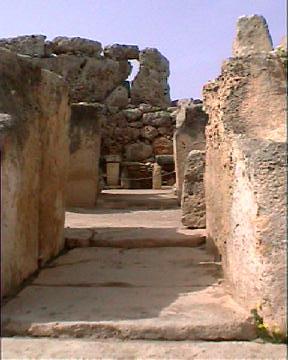 Ggantija Ggantija , Malta
-
The
temples on Malta are claimed to be some of the oldest free-standing temples in the
world.
A. Service
(6),
mentions the 'contemporary cement of the floor'
in the pavement of the Ggantija temple on Gozo, Malta (see
left), and
although the idea was not accepted for a long
time,
The pictures below show how some of the
temple floors
were paved with huge stones, a process also visible at several Maltese temples (Tarxien,
left and
Ggantija,
right).
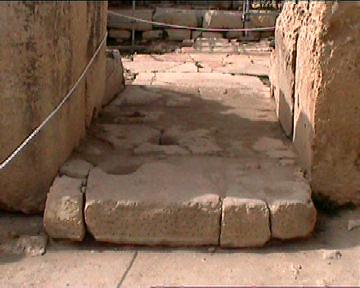
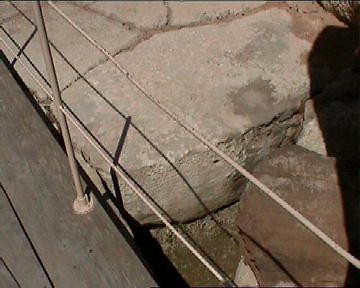
(More about the
Constructions of Prehistoric Malta)
|
| The
Specific Selection of Stone: |
While it is apparent that the
megalithic builders showed a preference for certain stone types, the
reason for this has yet to be explained satisfactorily. The extra
distance and effort required to employ specific stones in ancient
structures offers us with a clue as to the possible motivation of
the builders.
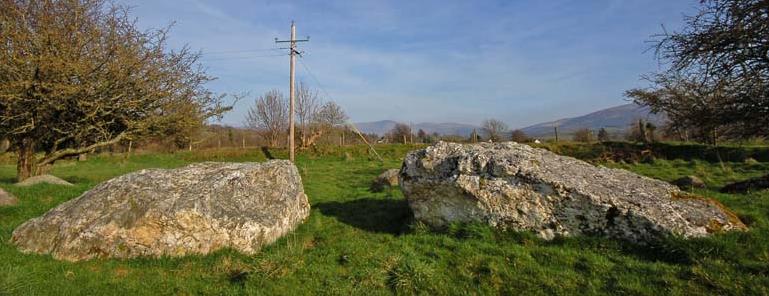
The immense White-quartz, portal-stones at
Castelruddery Henge-Circle in Ireland.
(More
about the Specific Selection of Stone in Prehistory)
|
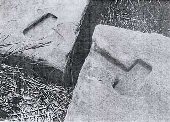
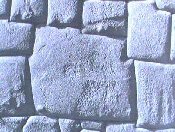
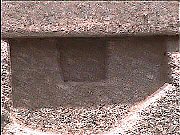
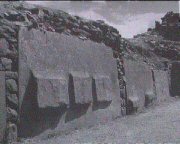
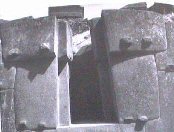









































 Trepanation:
Skulls with signs of trepanning were found practically in all
parts of the world where man has lived. Trepanning is probably
the oldest surgical operation known to man: evidence for it
goes back as far as in 40,000 year-old Cro-Magnon sites. The
Egyptians invented the circular trephine, made by a tube with
serrated borders, which cuts much easier by means of rotation,
and which was then extensively used in Greece and Rome, and
gave origin to the "crown" trephine, used in Europe from the
first to the 19th century.
Trepanation:
Skulls with signs of trepanning were found practically in all
parts of the world where man has lived. Trepanning is probably
the oldest surgical operation known to man: evidence for it
goes back as far as in 40,000 year-old Cro-Magnon sites. The
Egyptians invented the circular trephine, made by a tube with
serrated borders, which cuts much easier by means of rotation,
and which was then extensively used in Greece and Rome, and
gave origin to the "crown" trephine, used in Europe from the
first to the 19th century.




